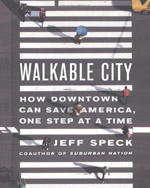|
Special Features





Image Libraries


|
|
Blog
Today would have been Jane Jacobs’ 100th birthdayJane Jacobs was born May 4, 1916, 100 years ago today. She left the world in 2006, but in her 89 years of life she revolutionized how we think about cities. Here is what GGWash contributors said about Jane, the patron saint of American urbanism.

Today’s Google Doodle honors Jane. Image from Google.
Jane’s most famous book, The Death and Life of Great American Cities, is required reading for anyone interested in the form of cities. It’s helped generations of Americans understand what makes places like Georgetown so pleasant, and places like Boston’s City Hall so repulsive.
Even 55 years after its publication, urbanists continue to obsess over Death and Life, debating obscure passages like clerics feuding over a religious text.
Ben Ross went straight to the point, then warned of the next great problem afflicting our cities:
Jane Jacobs was a true genius who developed a new paradigm of city planning. Our best city neighborhoods now suffer from the “curse of success” that she foresaw as the consequence of a scarcity of urbanism. How to overcome that scarcity is a problem that she left to us.
Canaan Merchant summarized two big lessons Jane taught him:
Look at what is actually happening rather than relying on what is “supposed” to happen. A city’s beauty lies in its people rather than its buildings. Bring the people out and the buildings will take care of themselves.
Former contributor Abigail Zenner focused on how Jane successfully communicated ideas:
She introduced many people to the world of planning and gave us words to describe what we see every day in cities but have a hard time explaining in simple language. She was able to make a case that stirred peoples’ hearts.
Nick Finio took a contrarian position, quoting a 1998 critique of Death and Life from UC Berkeley professor Roger Montgomery:
Let’s not glorify her too much. Montgomery’s critique ends with this zinger: “Taken together, these themes do add up. Anti-government and anti-regulation beliefs, confidence in the existence of a nearly perfect competitive market, inattention to corporate power, denial of social class and race as determinative categories, taken together look mighty like the core belief system of liberatarian conservatism.”
But other contributors were quick to jump to Jacobs’ defense. They pointed out that while her views may not be a perfect guide to urban issues today, her work helped surface notions that needed to come to the fore, like defending the idea of the city against car-oriented places, and eyes on the street maintaining safety.
Jonathan Krall added:
Just because Jacobs had a healthy mistrust for government and for large projects doesn’t mean she was espousing neo-conservatism. I agree with Montgomery that Jacobs’ excellent and helpful descriptions of healthy city life and associated planning issues skip over some very challenging social and political issues. However, I disagree with his implication that Jacobs is suggesting her readers should ignore those challenges.
Payton Chung opined on Jacobs’ motivations:
Just like any “bible,” there are bound to be contrary readings. There’s a fine line between libertarianism and anarchism, and I’d argue Jacobs’ overall oeuvre points to a mistrust of all large institutions, whether corporate or governmental.
When all was said and done, it may have been Brendan Casey who summed Jane up best:
The force was strong with that one.
What do you think of Jane, and of her impact on cities?
 Comment on this at the version cross-posted to Greater Greater Washington. Comment on this at the version cross-posted to Greater Greater Washington.
May 4th, 2016 | Permalink
Tags: history, people, urbandesign

Metro’s Richard Sarles announces retirement
|
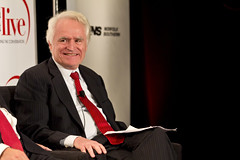
Richard Sarles. Photo by thisisbossi on Flickr. |
WMATA General Manager Richard Sarles announced at today’s Metro board meeting that he will retire, effective January, 2015.
The move comes as a surprise, since in 2013 Sarles agreed to a contract extension that would have kept him on the job until 2016. But not too much of a surprise: He’s 70 years old and has always said he didn’t intend to stay at WMATA long.
Sarles took charge of WMATA in 2010 and oversaw a significant rebuilding and safety-related overhaul of the transit system.
Metro board chairman Tom Downs says WMATA will conduct a nationwide search for Sarles’ replacement.
 Cross-posted at Greater Greater Washington. Cross-posted at Greater Greater Washington.
September 24th, 2014 | Permalink
Tags: government, metrorail, people, transportation

Will Cantor’s loss push congressional Republicans to balk on transportation compromise?Last night, US House majority leader Eric Cantor lost the Republican primary to a tea party challenger who painted Cantor as too willing to compromise with Democrats. Cantor’s loss makes this summer’s looming congressional fight over transportation funding all the more unpredictable.
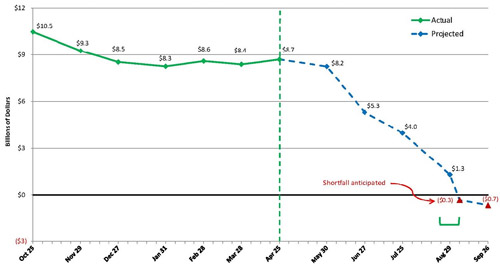
US Highway Trust Fund balance. If Congress doesn’t act soon, money will run out. Image from USDOT.
MAP-21, the federal transportation funding bill, expires in October. But USDOT will begin running out of money in August. Without a bipartisan bill to add new money, federal transportation funding will trickle to a halt.
Transportation wasn’t a major issue in Cantor’s election, but immigration reform was. Cantor mostly opposed immigration reform, but he briefly contemplated compromise, giving his more conservative opponent David Brat an opening to attack.
Some pundits fear that will push every other House Republican away from compromise in general, and grind whatever progress Congress was making on anything to a halt.
From an immigration perspective that probably makes little difference; House Republicans were not going to compromise anyway. But it could make a huge difference for transportation.
Transportation funding was a non-partisan issue in the 20th Century. Every 6 years Congress would pass a transportation bill with broad support from both parties. But in recent years, amid declining gas tax revenue and increasing need for supplemental funding, transportation has become a partisan spark.
Congress seemed primed to act, but now it’s an open question
Up until Cantor’s defeat, the general assumption in the transportation world has been that Congress would do something this summer. “Something” might mean a long term solution like a new bill and new taxes. Or it might mean a band-aid, like an extension of MAP-21 with an infusion of federal general fund dollars. Either way, Congress appeared to be making some progress.
But now? House Republicans might very well cease all legislative activity, and hope to ride out the rest of election season without upsetting their conservative base.
Polls show that raising money for transportation is popular, and voters rarely punish officials for doing so. But that may not matter to Republicans concerned about attacks from the extreme right.
While in Congress, Cantor fought against progressive transportation funding. But in this case his personal vote, and even his leadership on the specifics, might be less important than the simple fact that he was probably willing to advance a bill.
On the other hand, maybe the Republican establishment will take this as a call to arms, and moderate legislators will become more powerful. But that seems unlikely the day after the biggest tea party victory of the season.
 Cross-posted at Greater Greater Washington. Cross-posted at Greater Greater Washington.
June 11th, 2014 | Permalink
Tags: funding, government, people, transportation

Harriet Tregoning taking job at HUD
|
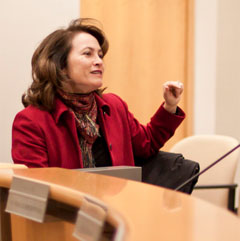
Photo from thisisbossi on flickr. |
Harriet Tregoning, Director of the DC Office of Planning, is resigning to take a job in the Obama administration as the Director of the HUD Office of Sustainable Housing and Communities.
The nation’s gain is DC’s loss. Tregoning has been one of the strongest regional voices for urbanism, transit, and smart growth.
With Arlington’s Chris Zimmerman also leaving local government this month, DC-area urbanists have big shoes to fill indeed.
February 4th, 2014 | Permalink
Tags: government, people

Shocked, saddened, don’t know what to sayMy friend and colleague Ron Kirby was shot and killed yesterday.
If you’ve worked in transportation planning in the DC area, you’ve met Ron. As Director of the TPB, he was smart as a whip and always enthusiastic. I’ll miss him terribly.
November 12th, 2013 | Permalink
Tags: people

My walkable living storyAlmost 4 in 10 DC households are car-free, and even more are car-light. That’s not because DC is full of car-hating zealots; it’s because life is simply more convenient that way, when the conditions are right.
When 5 minutes of walking, along a pleasant and safe sidewalk, can get you to most of your daily needs, and cycling or high-frequency transit can get to the rest, driving is more of pain than convenience. Especially when you factor in battling for parking and road rage, not to mention cost.
So when the Coalition for Smarter Growth started putting together Walkable Living Stories, about how and why so many DC residents go car-free or car-light, I wanted to participate. Here’s my story:
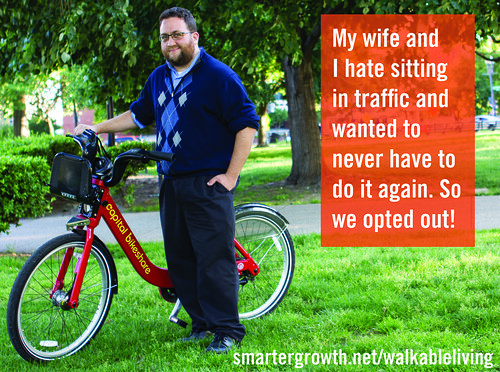
Photo from CSG.
“My wife and I hate sitting in traffic and wanted to never have to do it again. So we opted out! When we selected our apartment, we intentionally picked one in the densest part of DC. Within two blocks of our apartment we have a grocery store, convenience mart, dry-cleaner, hardware store, and several cafes. So almost all our daily errands are on foot, or Capital Bikeshare. My commute is on the 16th St. bus line, where buses come every few minutes (more often than Metro trains!), so we never have to wait long. And we never have to look for parking, because we don’t need any! Our apartment costs more than one in the suburbs would, but we don’t have a car payment, nor an insurance payment, nor any gasoline bills. We do occasionally rent cars for out-of-town trips, but that’s much less hassle and cost than car ownership.”
For more about CSG’s Walkable Living Stories project, visit their website, or see today’s big GGW post.
June 19th, 2013 | Permalink
Tags: people, The New America, transportation

Read Walkable City, by Jeff Speck
Walkable City describes the benefits of urbanism, and proscribes how to make good urbanism happen. It’s a worthy read, for both newbies and hardened Jane Jacobs veterans.
I don’t read many mass market city planning books anymore, because so many of them say the same things. But when I heard one of the authors of Suburban Nation had his own book, I had to give it a shot. Suburban Nation is still the most eminently readable and easy to understand discussion of 20th Century suburbs, and why urban neighborhoods are better.
In some ways, Walkable City is like all those other books. It says mixed use and transit are good, wide highways and blank walls are bad. Most of us in the city planning world already know these things.
But Walkable City is worth reading, because Speck gathers a mountain of data supporting most of the arguments in contemporary urbanism, and then presents it in a convincing, methodological, and easy to read way. If you already know the basics, Walkable City is the most complete reference available.
And it does have new arguments. For example, Speck’s discussion of walkable architecture is intriguing, and explains in detail why it isn’t the ornament of historic buildings that makes them superior to most contemporary ones, but that they have layers of interesting things to look at, from different scales, and that walkers can interact with them in ways other than staring at a wall (even a decorated one).
Maybe I just like the book because I’m in it. Much to my surprise. I was reading it one day on the Metro and then, unexpectedly, on page 58, saw my own name, quoted regarded LEED architecture.
But perhaps the best thing I can say about Walkable City is this: After reading the first couple of chapters in a cafe, I went home, got a pen, and started over. Now my copy is covered with notes and squiggles from front to back.
May 6th, 2013 | Permalink
Tags: people, urbandesign

Foxx has the makings of a great Transportation Secretary
|

Charlotte streetcar construction. Photo by Reconnecting America on flickr. |
President Obama yesterday nominated Charlotte Mayor Anthony Foxx as the next Secretary of Transportation. If Foxx’s experience in Charlotte is any indication, he’ll make a strong choice.
During his nomination press conference, Foxx said “cities have had no better friend” than the US Department of Transportation under outgoing Secretary Ray LaHood, and that if confirmed he would hope to “uphold the standards” LaHood set. That’s great news.
The fact that Foxx comes from a major central city is also a huge benefit. It means he understands urban needs, which aren’t just highways.
Charlotte may not be New York, but it’s made great strides in the right direction. The city’s first rail line opened a few years ago, and a streetcar line is under construction now. Charlotte also gained bronze-level status as a bike friendly community in 2008, and launched bikesharing in 2012.
Foxx has been a strong advocate for urban rail, especially streetcars. He knows transportation and land use are tied at the hip, and has fought repeated attacks on Charlotte’s streetcar by former Mayor and current North Carolina Governor Pat McCrory.
He’s also worked as an attorney for bus manufacturer DesignLine.
Foxx also knows that state Departments of Transportation can sometimes be part of the problem. At the federal level, it’s common for USDOT to delegate responsibilities and funding to state DOTs, under the assumption the states have a better understanding of local needs. But state DOTs aren’t any more local than any huge centralized government. And since they usually focus on highways, the result is that federal dollars mostly go to highways as well.
Since Foxx fought with the state over Charlotte’s streetcar, he knows that funneling everything through state DOTs means states hold the cards. He knows that can hurt cities.
Finally, Foxx hired Arlington, VA’s former county manager, Ron Carlee, to run Charlotte’s city government. Foxx would have heard about Arlington’s reputation for progressive transportation planning during the hiring process, and presumably counted it in Carlee’s favor.
Of course, no one can really predict what kind of Secretary Foxx will be. When progressive champion Ray LaHood was first tapped for the job, the blogosphere worried his history as a Republican from rural Illinois meant he’d be a status quo highway builder.
But we do know that Foxx has made a priority of building transit in his home city, and has had to fight to make it happen.
 Cross-posted at Greater Greater Washington. Cross-posted at Greater Greater Washington.
April 30th, 2013 | Permalink
Tags: bus, government, lightrail, people, roads/cars, streetcar, transportation

You can bet I’ll never be giving any money to AAAAAA’s official company spokesman John Townsend says GGW’s David Alpert is a “nerd,” a “ninny,” is “developmentally retarded,” and is “like the Klan.”
If AAA thinks it’s good business practice for its spokespeople to make offensive personal attacks, then AAA isn’t a company I will ever have anything to do with. I don’t currently own a car, but someday I probably will. AAA won’t be my insurance partner when that day comes.
And in the mean time, if this is how AAA thinks and represents itself, guess how seriously I take their positions on transportation issues.
April 18th, 2013 | Permalink
Tags: people, roads/cars, transportation

Can Eleanor Holmes Norton help DC deal with NPS?The National Park Service doesn’t understand cities, or how parks in cities function. They operate parks in DC the same way they operate Yellowstone, with a focus on rural-style limited access and conservancy rather than urban-style openness.
This is a big problem for DC, since NPS owns the National Mall, Rock Creek Park, most of the circles and squares, and a ton of other properties in the city, almost all of which are mismanaged given their urban context. Corner plazas that should be open all the time close at dusk. Statues that were built for people to sit on are fenced off. The Arboretum thinks too many people visit. Rock Creek Park is under programmed compared to other large city parks like Central Park or Golden Gate Park. The only mode of transportation access allowed on the National Mall is expensive tourist trams. Park Police stomp out any expressions of freedom at the monument for the country’s most libertarian president. And, most recently, we’re told that NPS thinks bikes would “destroy the nature” of the National Mall.
Since the NPS (and in the case of the Arboretum, the Dept. of Agriculture) is a federal agency, neither the city nor its residents can do much of anything to argue in favor of the position that city parks should be available for use by city people. But there is one person who might be in a position to make a difference: DC’s non-voting Congressional representative Eleanor Holmes Norton.
Would it be possible for Eleanor to pressure NPS to treat its urban properties more appropriately? Would legislation be appropriate? Would a Congress that can’t agree on DC voting rights be amenable to loosening inappropriate regulations applied to DC parks?
As a District resident I want Ms. Norton to continue working on full representation for DC as much as anyone, but in the mean time I also wonder if this is the sort of shorter-term problem that we should be asking for her help to solve.
July 19th, 2011 | Permalink
Tags: government, people

|
Media





Site
About BeyondDC
Archive 2003-06
Contact
Category Tags:
Partners
|

 Comment on this at the version cross-posted to Greater Greater Washington.
Comment on this at the version cross-posted to Greater Greater Washington.













